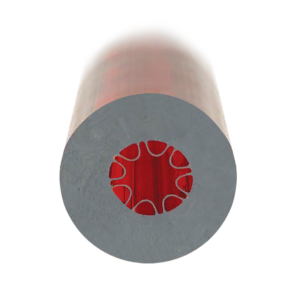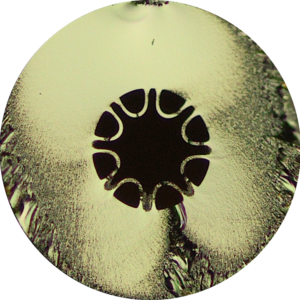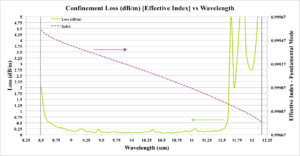Hollow-Core Fiber with Anti-Resonant Arches (HC-ARA Fiber) - Patented
Hollow-core anti-resonant (HC-AR) fiber is an alternative approach to hollow-core photonic band gap fiber to minimize the light overlap in the glass struts and to transmit very high power/energy laser. The anti-resonance in the thin glass struts at the interface of the hollow core and the cladding efficiently reflects and confines the light in the hollow core. Silica HC-AR fiber cannot transmit wavelengths >4.5 micron because the small portion of the guided light that interacts with the silica glass struts is highly absorbed and light does not propagate far. The use of infrared chalcogenide glass for the fabrication of HC-AR fiber is attractive for extending laser transmission to longer wavelengths in the infrared (1-15 micron).
IRflex’ innovative hollow-core fiber with anti-resonant arches (HC-ARA) is designed and made of chalcogenide glass As2S3. The HC-ARA fiber has a single layer of eight non-touching curved arches, each one being solidly attached at two locations on the outer solid region to prevent any lateral displacement and to preserve the arches’ shape and uniformity during the fabrication process. The thickness and spacing between the arches are selected respectively to minimize the fiber transmission loss <0.1 dB/m for CO2 laser between 9 to 11 micron, CO laser around 5 micron or Er:YAG laser around 3 micron. Also, the higher order modes of the HC-ARA fiber are more attenuated than the fundamental mode, so the fiber is effectively single mode after only a few meters. The HC-ARA preform is made by extrusion of chalcogenide glass through a die specifically designed to produce the anti-resonant arches. The extruded HC-ARA preform is pulled in a fiber using photonic crystal fiber draw techniques.
IRflex Corporation has filled the patent of this novel design and technology in April 2019 and has been granted the patent by the United States Patent and Trademark Office on October 27, 2020. The patent no. is US 10,816,721 B1.
The chalcogenide HC-ARA fiber can be designed to transmit high-power lasers in the infrared such as CO2 laser at 10.6 micron (or other wavelengths in the region of 9 -11 micron), CO laser around 5 micron, or Er:YAG laser around 3 micron by increase/decrease arches thickness and spacing between the arches. Currently, our R&D team focus to finalize the design/packaging for HC-ARA fiber for CO2 laser between 9 to 11 µm in the commercial field.
Key Features
- High power/energy laser transmission: >50W CW
- >99% of the optical power/energy is confined in the hollow core
- Low loss <0.1dB/m
- Good beam quality M2~1
- Optimized design options for wavelength around 3µm, 5µm and 8.7 to 11.55µm
- Can be gas filled
- Low bend loss
Applications
High-power/energy laser transmission
- CO2 laser: 9 to 11µm
- CO laser: 5µm
- Er:YAG laser: 3µm
Medical Lasers
- Dentistry
- Cosmetic Surgery
- Therapeutic
Gas Spectroscopy
Sensors
Preliminary Technical Specifications
| Transmission Window (µm)1 | 8.70 - 11.55 |
| Bend Radium |
15 cm |
| Effective Core Diameter | 185µm |
| Cladding Diameter | 610µm |
Fundamental Mode Characteristics
| Design Wavelength (λD) | 10.6 μm |
| Fundamental Mode Loss @ λD | 0.08 dB/m |
| Effective Fundamental Mode Index @ λD | 0.99914 |
| Numerical Aperture2 @ λD | 0.067 |
| Fill Factor3 @ λD | 99.58% |
| Mode Field Diameter4 @ λD | 141 μm |
| Mode Loss at a bend radius of 15cm @ λD | < 0.20 dB/m |
1) Specified for wavelengths with fundamental mode loss ≤ 0.5 dB/m.
2) Taken as the sine of the angle at which the intensity falls to 5% of its maximum value in the far field.
3) Fraction of mode power flux contained in a radius of 92.5 μm from the center of the hollow core. (This region is essentially air)
4) FW1/e2 of the intensity distribution.
Fiber transmission optimized for wavelength from 8.7 to 11.55 micron
Calculated Loss spectrum for chalcogenide HC-ARA fiber with 8 anti-resonant arches of thickness 3.9 micron, 185 micron core diameter and 21.45 micro gap.
Disclaimer: The specifications and graphics presented in this sheet are preliminary results of numberical calculations ran with commercially available software using the Finite Element Method and a triangular adaptive mesh with PML.






